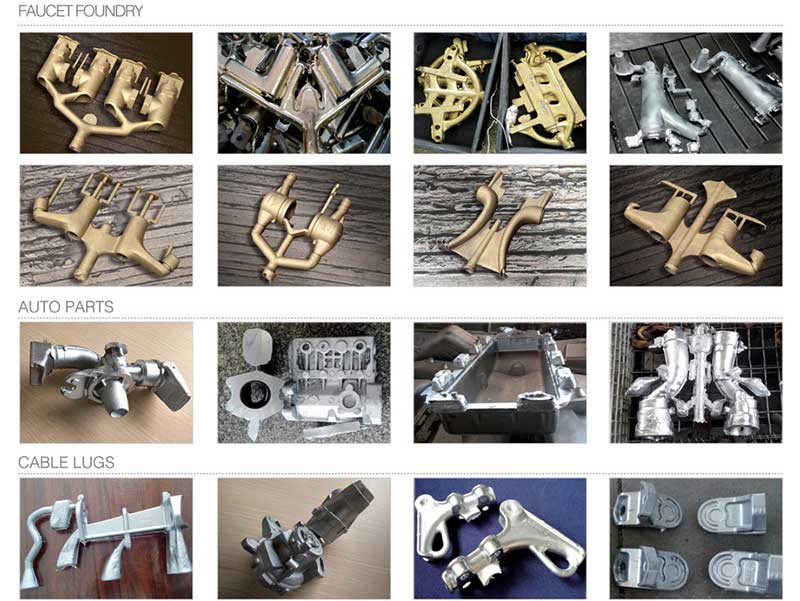Causes of metal casting defects and prevention methods
Common metal casting defects include pores, choking, shrinkage, and slag holes. What are the reasons for their formation, what alloys are they common in, and what are the prevention methods? This article will reveal to you.
Causes of metal casting defects and prevention methods
1. Stoma (bubbles), choking and air pockets
Stomatal pores, one of metal casting defects, which are holes that exist on the surface or inside of castings, which are round, oval or irregular. Sometimes multiple pores form a pore cluster, and the subcutaneous pores are generally pear-shaped.
The choking holes are irregular in shape and rough on the surface. The air pockets are concave on the surface and the surface is relatively smooth, which can be found by the appearance inspection of the open holes. Subcutaneous stomata can only be found after machining.
The surface of the relatively shallow subcutaneous pores of light alloy castings is dark gray after sand blowing. Sometimes the tip of the pear-shaped pores is exposed on the surface of the casting, which can be seen on visual inspection.
Important castings are inspected by X-ray for pores, and the pores appear black on the X-ray film. Stomas can also be found in fracture and low-power inspection.
Due to the effect of the alloy and the gas forming the pores, the surface of the pores have different colors.
The bubbles of metal casting defects cause analysis:
1. The preheating temperature of the metal mold is too low, and the liquid metal cools too fast when passing through the pouring system.
2. The metal exhaust design is poor, and the gas cannot be discharged smoothly.
3. The paint is not good, the paint itself has poor exhaust performance, and even decomposes gas.
4. There are shrinkage holes and pits on the surface of metal molds and outer chilled iron. After the liquid metal is injected, the gas at the shrinkage holes and pits rapidly expand and press into the alloy liquid to form pores or choking holes.
5. The metal surface is corroded and not cleaned up.
What alloys are commonly found in metal casting defects:
Various alloys are common, non-ferrous alloy castings (especially tin bronze, etc. (should pay special attention).
The bubbles of metal casting defects prevention method:
1. Metal type and metalcore should be baked thoroughly after spraying and repainting; do not use too thin paint; absolutely can not wipe off after paint; respray immediately after paint falls off; When there are choking holes on the paint surface, scrape off the paint and spray again.
2. Use inclined pouring (some defect prevention methods can be achieved by directly eliminating the cause of the defect formation; for example, the cause of the defect formation is “the preheating temperature of the metal type is too low”, the prevention method is “increase the preheating temperature of the metal type”).
2. Shrinkage and shrinkage
Shrinkage holes, another one of metal casting defects, which are bright or dark holes with rough surfaces in castings. When the shrinkage cavity is slight, there are many scattered small shrinkage holes, that is, shrinkage porosity. The shrinkage cavity or shrinkage porosity place has coarse grains, and the fracture surface shows different colors after heat treatment.
The shrinkage porosity of light alloy castings is cloudy and severely filamentous on the X-ray film, and the surface is loose and densely dotted in the fluorescence. Shrinkage and porosity often occur in the vicinity of the gate, the root of the riser, the thick part, the thickness of the wall, and the thin wall with a large plane.
The shrinkage holes of metal casting defect cause analysis:
1. The working temperature of the metal mold does not meet the requirements of sequential solidification.
2. Poor choice of paint and poor control of paint layer thickness.
3. Improper design of the position of the casting in the metal mold.
What alloys are commonly found in metal casting defect:
Shrinkage porosity defects can occur in various alloys, and the shrinkage porosity tendency of cast steel in ferrous metals is greater than that of cast iron;
Among cast irons, malleable cast iron and ductile cast iron have a greater shrinkage tendency than ordinary gray cast iron, and cast non-ferrous alloys have a greater shrinkage tendency than ferrous metals. The shrinkage porosity of magnesium alloy is greater than that of aluminum alloy. Tin bronze, brass, etc. are prone to shrinkage.
The shrinkage holes of metal casting defect prevention method:
1. Increase the working temperature of metal molds.
2. Adjust the thickness of the paint; spray the paint evenly; when the paint is dropped and repainted, local accumulation should not be formed.
3. Local heating of metal type, or asbestos insulation.
4. The inlaid steel block in the hot section is returned and cooled.
5. The metal mold is equipped with heat sinks, water, etc. to return the local cooling rate, or spray water or spray outside the mold.
6. Use a detachable chill block, which is installed in the metal mold in rotation.
7. Compressed air pressurizing device is installed on the metal type riser.
3. Slag hole (flux slag inclusion or oxidation slag inclusion)
The slag hole is an open hole or a dark hole on the casting, which is the third metal casting defects, all or part of the hole is blocked by the slag, and the shape is irregular. It is not easy to find slag inclusions in the flux. The internal flux slag on the X-ray film is generally white round or snowflake flakes, or small dots;
The fracture is dark gray; after the slag is removed, smooth holes appear, generally distributed in the lower part of the pouring position, near the inner gate or at the dead corner of the cast iron.
The oxidized slag is mostly distributed on the surface of the casting near the inner gate in a net shape, sometimes in the form of flakes, irregular clouds with wrinkles; or forming a sheet-like interlayer in the mold;
Or it is stored in the castings in the form of flocs. When the fracture is broken, it often breaks from the interlayer and the oxide skin is sandwiched in it, which is one of the root causes of cracks.
The fracture has different colors. The oxidized slag on the X-ray film is black lumps or irregular clusters.
The slag hole of metal casting defect cause analysis:
The slag hole is mainly caused by the problems of metallurgy, operation and pouring system. From the metal type, it will not cause a slag hole, and it is an effective way to avoid the formation of a slag hole.
What alloys are commonly found in metal casting defect:
Slag holes may appear in various alloy castings. However, there are more non-gold alloys for casting, and there are differences. Generally, aluminum alloys are not prone to flux slag, and oxidation slag tends to be greater. Aluminum bronze, manganese brass, etc. are prone to oxidize slag.
Delin Machinery specializes in the production of the metal casting machine. It is a machinery manufacturing enterprise integrating scientific research, design, manufacturing, installation, debugging and consulting services. You can click here: metal casting machine(gravity casting machine) to view more machine introduction, and maybe you are interested in machine video: gravity casting machine working process
Welcome to Call / WhatsApp or send us Email about any question on the horizontal sand molding machine, please contact us >>>Tel / WhatsApp / WeChat: +86 13960339790, Email: salse16@chinamakeco.com

